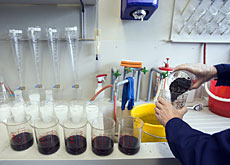Zurich bathing pools inspire New York project

A new floating swimming pool that opened last month on New York's East River was partly inspired by the popular lakeside bathing facilities in Zurich.
The architects of the New York pool, built inside a barge, commissioned a report on Zurich’s pontoon swimming areas and were particularly impressed with how they allowed people to enjoy the waterfront.
With temperatures soaring on the east coast, it has proved a huge hit since opening on American Independence Day, July 4. Some 40,000 people enjoyed the facilities in the first month.
A century ago New York had 15 swimming pools open to the river that served as a focus point for the various nationalities of immigrants, substituting for baths or showers in addition to their recreational use.
Project leader Ann Buttenwieser explained to swissinfo that she wanted to reintroduce swimming areas that were a popular draw in the 19th century before fading away in the 1920s and 1930s as waterways became polluted.
“I was interested in improving the waterfront and getting people out to it again so they could appreciate that they are on an island city. A floating pool on the river is perfect for that,” she said.
Part of her research involved finding out more about swimming pools in different countries. A detailed study of three pools in Zurich and one on lake Lugano in the south of Switzerland left a particular impression.
Swimmers underserved
“One of the things that was interesting was multiple usage of these pools. It was not just a place to swim but also for parties and for people to hang out and have dinner – a venue that allowed people to combine a number of activities out on the water,” she said.
Regulatory restrictions mean the pool had to be completely enclosed in the barge, unlike the Zurich facilities that are open to the water, and could not offer other activities such as restaurants or bars.
Plans for a snack bar had to be put on ice at the floating pool’s present location near to Brooklyn Bridge. However, a nearby beach adds a different dimension to the present recreational area.
The floating pool has a capacity of 170. To accommodate the crowds of swimmers flocking to the attraction organisers have been forced to limit bathing time to one or two-hour sessions at peak times.
Enthusiastic response
“When I walk in they clap and accost me to tell me how wonderful it is. It’s an amazing experience. The swimmers are from across the board, a rainbow of hues – all different kinds of people using it,” said Buttenwieser.
Buttenwieser, a waterfront planner, first dreamt up the idea more than a quarter of a century ago after reading about New York’s former river swimming areas.
The project took a lot of effort to get off the ground and was even hampered by the catastrophic Hurricane Katrina that devastated New Orleans in 2005 just as the barge was being built there.
And Buttenwieser’s work is not finished yet. The floating pool is a non-profit enterprise and the Neptune Foundation that was set up to realise the project is currently looking for $1 million (SFr1.2 million) from the public to pay off its initial capital debts.
The pool will also have to find a new home next year as developments at its present home in the Brooklyn Bridge Park Conservancy area will make it inaccessible next summer.
“I live moment by moment, just as I have done for 27 years when I first dreamed up the project,” Buttenwieser said.
swissinfo, Matthew Allen
The New York pool, also known as the Floating Pool Lady, is 25 metres long built into a 78-metre-long barge. The water does not come from the river – that is considered unfit for swimming in – but from the shore.
It comes under the jurisdiction of the Brooklyn Bridge Park Conservancy in its present location.
A company called American Leisure operates the pool, providing lifeguards and other staff, and running classes in swimming, aerobic water exercise and synchronised water ballet. Other attractions at the pool include water volleyball and swim races.
It will cost an estimated $200,000-300,000 (SFr240,000-360,000) to run each year.
Zurich boasts the highest concentration of public baths of any city. It has 26 in total, including 18 popular lakeside and riverside lidos open to the water on pontoon structures. Unsupervised swimming in Lake Zurich was banned until the end of the Second World War.
Some of the most popular venues are the Schanzengraben lido that turns into the Rimini bar at night, Utoquai lido, the lakeside lido in Enge and the oldest lido in Zurich (originally built in 1837 and rebuilt in 1888) next to the town hall (Stadthausquai) for women only.
By evening, some offer a range of cultural highlights including concerts, theatricals, sports and poetry slams.
A 1999 study of Zurich’s swimming pools, commissioned by the Neptune Foundation, found that nearly 900,000 people used the outdoor facilities in 1998.
This number has dropped from 1.74 million in the 1960s and around a million in the early 1990s, the report concludes. More up-to-date collated figures are presently unavailable.

In compliance with the JTI standards
More: SWI swissinfo.ch certified by the Journalism Trust Initiative










You can find an overview of ongoing debates with our journalists here . Please join us!
If you want to start a conversation about a topic raised in this article or want to report factual errors, email us at english@swissinfo.ch.